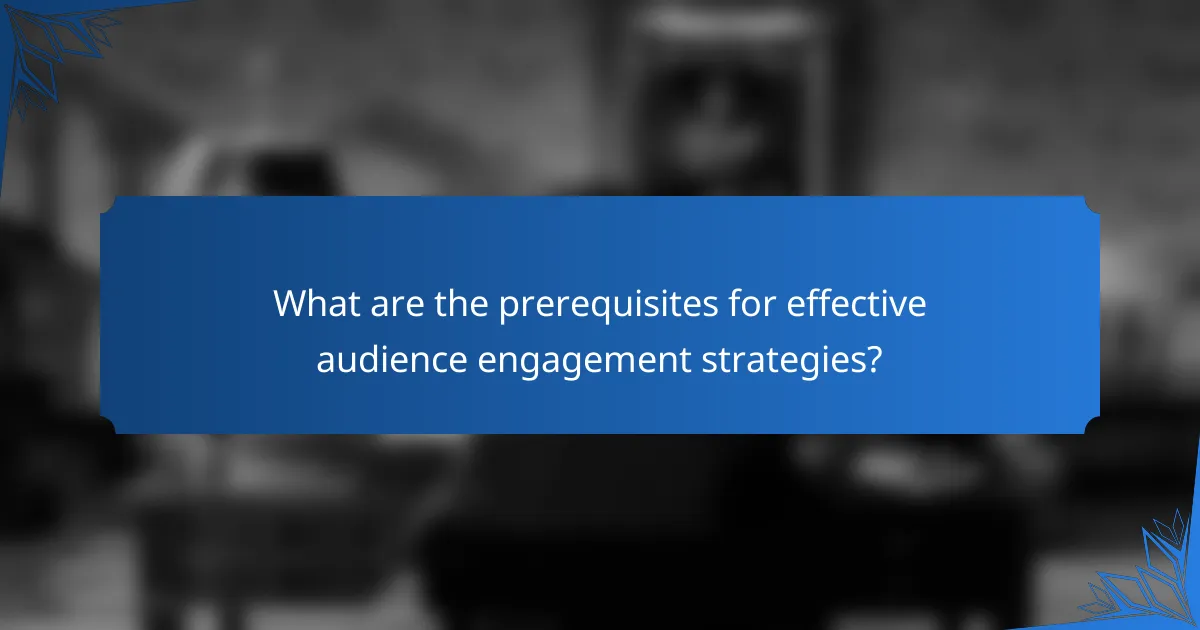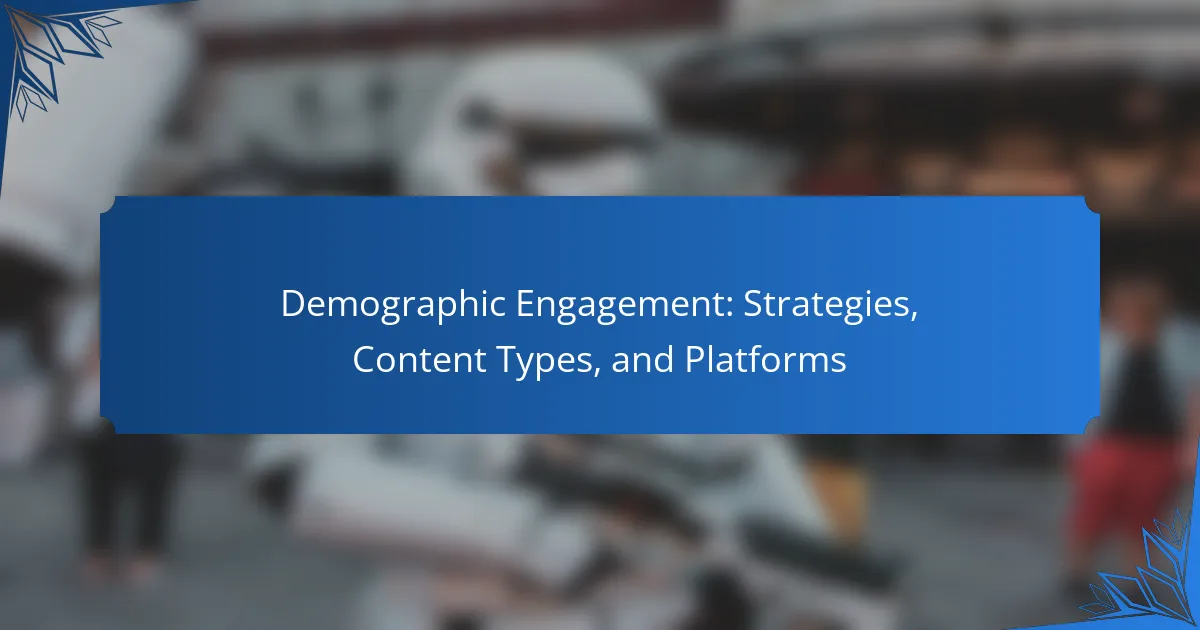Engaging your audience is crucial for building lasting connections and loyalty. By incorporating interactive content, you can actively involve users in their experience, making it more memorable. Additionally, effective feedback mechanisms encourage direct communication, fostering a sense of community that keeps audience members invested and engaged.

How can interactive content boost audience engagement?
Interactive content significantly enhances audience engagement by actively involving users in the experience. This type of content encourages participation, making it more memorable and effective in retaining attention compared to passive formats.
Quizzes and polls
Quizzes and polls are effective tools for engaging audiences by inviting them to share their opinions or test their knowledge. They can be easily integrated into websites or social media platforms, allowing users to participate quickly and effortlessly. For example, a brand might create a fun quiz related to its products, encouraging users to discover which item suits them best.
To maximize engagement, ensure that quizzes are relevant and entertaining. Avoid overly complex questions, and keep the length manageable—typically between 5 to 10 questions works well.
Interactive infographics
Interactive infographics present data in a visually engaging way, allowing users to explore information at their own pace. By incorporating clickable elements, such as charts or maps, users can delve deeper into specific data points that interest them. This format not only informs but also encourages exploration and retention of information.
When creating interactive infographics, focus on clarity and usability. Use simple navigation and ensure that the design is mobile-friendly, as many users access content via smartphones.
Augmented reality experiences
Augmented reality (AR) experiences offer immersive interactions that blend digital content with the real world. This technology can enhance product demonstrations, allowing users to visualize how items would look or function in their own environment. For instance, a furniture retailer might use AR to let customers see how a sofa fits in their living room.
Implementing AR requires careful planning and technology considerations. Ensure that the experience is intuitive and accessible, as complicated setups can deter users from engaging.
Gamified content
Gamified content incorporates game-like elements into non-game contexts to motivate and engage users. This can include point systems, badges, or leaderboards that reward participation and achievement. For example, a fitness app might gamify workouts by allowing users to earn points for completing challenges.
To effectively gamify content, focus on clear goals and rewards that resonate with your audience. Avoid making the experience overly competitive, as this can discourage participation among less confident users.
Live webinars
Live webinars provide a platform for real-time interaction between presenters and audiences, fostering engagement through Q&A sessions and discussions. They allow for in-depth exploration of topics and can be tailored to address specific audience interests. For instance, a marketing expert might host a webinar on current trends, inviting questions from attendees.
To enhance the effectiveness of webinars, promote them in advance and encourage audience participation through polls or chat features. Keep sessions concise, ideally lasting between 30 to 60 minutes, to maintain attention and interest.

What feedback mechanisms enhance audience interaction?
Effective feedback mechanisms significantly boost audience interaction by providing channels for direct communication and input. These tools not only gather opinions but also foster a sense of community and engagement among users.
Surveys and questionnaires
Surveys and questionnaires are structured tools that collect audience opinions on specific topics. They can be distributed via email, embedded on websites, or shared through social media platforms. Aim for concise questions to maintain engagement, and consider offering incentives like discounts or exclusive content to increase response rates.
When designing surveys, use a mix of multiple-choice and open-ended questions to gather both quantitative and qualitative feedback. A typical completion time should be under five minutes to maximize participation.
Comment sections
Comment sections allow users to share their thoughts directly on content pages, fostering real-time interaction. They encourage discussions and provide immediate feedback on articles, videos, or posts. Moderation is essential to maintain a positive environment and prevent spam or abusive comments.
To enhance engagement, consider highlighting popular comments or responding to user inquiries promptly. This interaction can lead to a more vibrant community and encourage repeat visits.
Social media feedback
Social media platforms serve as dynamic venues for audience feedback, allowing users to express opinions through comments, shares, and reactions. Engaging with followers by asking questions or creating polls can yield valuable insights into audience preferences and trends.
Utilize analytics tools to track engagement metrics and identify which types of content resonate most with your audience. Regularly responding to comments and messages can strengthen relationships and encourage further interaction.

How does community building improve audience loyalty?
Community building fosters a sense of belonging among audience members, which significantly enhances their loyalty. When individuals feel connected to a group, they are more likely to engage consistently and advocate for the brand or platform.
Online forums and discussion groups
Online forums and discussion groups provide a dedicated space for audience members to share ideas, ask questions, and engage in conversations. These platforms encourage interaction and can lead to deeper relationships among users, which strengthens loyalty. For example, a niche forum about a specific hobby can create a tight-knit community where members feel valued and heard.
To effectively manage online forums, ensure that moderators are active and that discussions remain respectful and on-topic. Regularly highlight popular threads or user contributions to maintain engagement and encourage participation.
Social media communities
Social media communities leverage platforms like Facebook, Instagram, or Reddit to create interactive spaces where audiences can connect. These communities allow for real-time engagement and can quickly amplify brand messages through shares and comments. For instance, a brand might create a Facebook group for its customers to share tips and experiences, fostering a sense of community.
When building social media communities, focus on consistent content that encourages interaction. Use polls, Q&A sessions, and live events to keep the community active and engaged. Avoid overly promotional posts, as they can drive members away.
User-generated content initiatives
User-generated content initiatives invite audience members to contribute their own content, such as reviews, photos, or videos. This not only enriches the community but also empowers users, making them feel more invested in the brand. For example, a travel company might encourage customers to share their travel stories, showcasing them on the company’s website or social media channels.
To successfully implement user-generated content initiatives, establish clear guidelines on what types of content are acceptable and how they will be used. Recognize and reward contributions to motivate continued participation, such as featuring top contributors or offering small incentives.

What are the prerequisites for effective audience engagement strategies?
Effective audience engagement strategies require a clear understanding of your target audience and well-defined goals. These elements are essential for creating meaningful interactions that resonate with your audience and foster community involvement.
Understanding target demographics
To engage your audience effectively, you must first identify and understand their demographics. This includes factors such as age, gender, location, interests, and behaviors. Tailoring your content to these characteristics can significantly enhance engagement.
Utilize surveys, social media analytics, and customer feedback to gather insights about your audience. For instance, if your primary demographic is millennials, consider using platforms like Instagram or TikTok for content delivery, as these channels are popular among that age group.
Setting clear engagement goals
Establishing clear engagement goals is crucial for measuring success and guiding your strategies. Goals should be specific, measurable, achievable, relevant, and time-bound (SMART). For example, aim to increase user interaction on social media posts by 20% over the next three months.
Regularly review and adjust your goals based on audience feedback and engagement metrics. Avoid vague objectives; instead, focus on actionable targets, such as increasing newsletter sign-ups or boosting comments on blog posts. This clarity will help maintain focus and drive effective engagement efforts.

How can brands measure the success of engagement strategies?
Brands can measure the success of engagement strategies by analyzing various metrics that reflect audience interaction and satisfaction. Key indicators include engagement metrics, conversion rates, and community feedback, which together provide a comprehensive view of how well strategies are performing.
Engagement metrics analysis
Engagement metrics analysis involves assessing data points such as likes, shares, comments, and time spent on content. These metrics help brands understand how effectively their content resonates with the audience. For instance, a high number of shares may indicate that the content is valuable and shareable, while low engagement could suggest a need for content refinement.
To effectively analyze engagement metrics, brands should establish benchmarks based on industry standards. Comparing performance against competitors can provide insights into areas for improvement. Regularly reviewing these metrics allows brands to adapt their strategies to better meet audience preferences.
Conversion rate tracking
Conversion rate tracking measures the percentage of users who complete a desired action, such as making a purchase or signing up for a newsletter. This metric is crucial for determining the effectiveness of engagement strategies in driving tangible results. Brands should aim for a conversion rate that aligns with industry averages, typically ranging from 1% to 5% depending on the sector.
To enhance conversion rates, brands should analyze user behavior through tools like A/B testing and heatmaps. These tools can reveal which elements of a campaign are most effective. Additionally, optimizing landing pages and ensuring a seamless user experience can significantly improve conversion outcomes.

What emerging trends are shaping audience engagement?
Emerging trends in audience engagement focus on interactive content, real-time feedback, and community building. These strategies enhance user experience and foster deeper connections between brands and their audiences.
Interactive Content
Interactive content, such as quizzes, polls, and interactive infographics, actively involves users, making them more likely to engage with the material. This type of content encourages participation and can lead to higher retention rates compared to static content.
To implement interactive content effectively, consider the preferences of your target audience. For instance, younger demographics may respond better to gamified experiences, while professionals might prefer informative tools like calculators or assessments.
Feedback Mechanisms
Incorporating feedback mechanisms allows audiences to share their thoughts and experiences, creating a two-way communication channel. Surveys, comment sections, and social media interactions are valuable tools for gathering insights and improving content.
When designing feedback opportunities, keep them simple and accessible. Aim for short surveys that take only a few minutes to complete, and ensure that users can easily find where to share their feedback. This encourages participation and shows that you value their opinions.
Community Building
Community building involves creating spaces where audiences can connect, share ideas, and support one another. Online forums, social media groups, and membership programs are effective ways to foster a sense of belonging among users.
To cultivate a thriving community, focus on providing value through exclusive content, regular interactions, and opportunities for members to contribute. Establishing clear guidelines and encouraging positive interactions can help maintain a welcoming environment.



